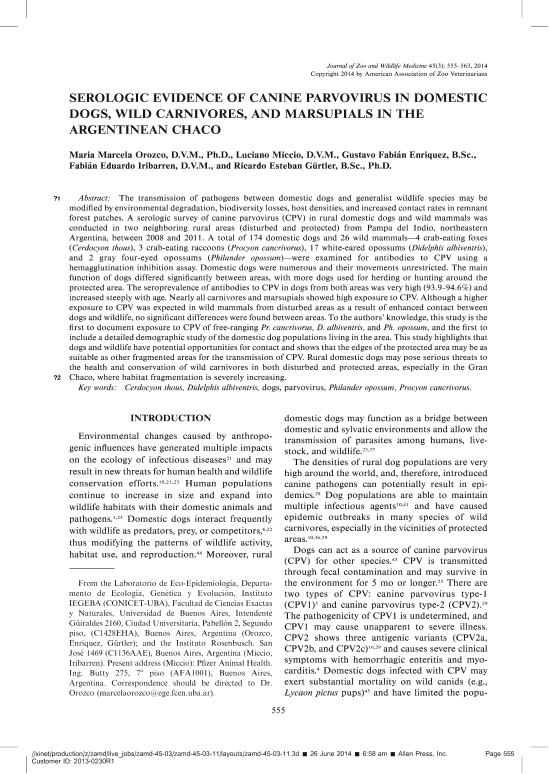Mostrar el registro sencillo del ítem
dc.contributor.author
Orozco, Maria Marcela

dc.contributor.author
Miccio, Luciano
dc.contributor.author
Enriquez, Gustavo Fabián

dc.contributor.author
Iribarren, Fabián Eduardo
dc.contributor.author
Gurtler, Ricardo Esteban

dc.date.available
2017-12-28T21:01:48Z
dc.date.issued
2013-09
dc.identifier.citation
Orozco, Maria Marcela; Miccio, Luciano; Enriquez, Gustavo Fabián; Iribarren, Fabián Eduardo; Gurtler, Ricardo Esteban; Serologic evidence of canine parvovirus in domestic dogs, wild carnivores, and marsupials in the argentinean Chaco; American Association of Zoo Veterinarians; Journal of Zoo and Wildlife Medicine; 45; 3; 9-2013; 555-563
dc.identifier.issn
1042-7260
dc.identifier.uri
http://hdl.handle.net/11336/31902
dc.description.abstract
The transmission of pathogens between domestic dogs and generalist wildlife species may be modified by environmental degradation, biodiversity losses, host densities, and increased contact rates in remnant forest patches. A serologic survey of canine parvovirus (CPV) in rural domestic dogs and wild mammals was conducted in two neighboring rural areas (disturbed and protected) from Pampa del Indio, northeastern Argentina, between 2008 and 2011. A total of 174 domestic dogs and 26 wild mammals—4 crab-eating foxes (Cerdocyon thous), 3 crab-eating raccoons (Procyon cancrivorus), 17 white-eared opossums (Didelphis albiventris), and 2 gray four-eyed opossums (Philander opossum)—were examined for antibodies to CPV using a hemagglutination inhibition assay. Domestic dogs were numerous and their movements unrestricted. The main function of dogs differed significantly between areas, with more dogs used for herding or hunting around the protected area. The seroprevalence of antibodies to CPV in dogs from both areas was very high (93.9–94.6%) and increased steeply with age. Nearly all carnivores and marsupials showed high exposure to CPV. Although a higher exposure to CPV was expected in wild mammals from disturbed areas as a result of enhanced contact between dogs and wildlife, no significant differences were found between areas. To the authors' knowledge, this study is the first to document exposure to CPV of free-ranging Pr. cancrivorus, D. albiventris, and Ph. opossum, and include a detailed demographic study of the domestic dog populations living in the area. This study highlights that dogs and wildlife have potential opportunities for contact and shows that the edges of the protected area may be as suitable as other fragmented areas for the transmission of CPV. Rural domestic dogs may pose serious threats to the health and conservation of wild carnivores in both disturbed and protected areas, especially in the Gran Chaco, where habitat fragmentation is severely increasing.
dc.format
application/pdf
dc.language.iso
eng
dc.publisher
American Association of Zoo Veterinarians

dc.rights
info:eu-repo/semantics/openAccess
dc.rights.uri
https://creativecommons.org/licenses/by-nc-sa/2.5/ar/
dc.subject
Serologic
dc.subject
Parvovirus
dc.subject
Dogs
dc.subject
Chaco
dc.subject.classification
Epidemiología

dc.subject.classification
Ciencias de la Salud

dc.subject.classification
CIENCIAS MÉDICAS Y DE LA SALUD

dc.title
Serologic evidence of canine parvovirus in domestic dogs, wild carnivores, and marsupials in the argentinean Chaco
dc.type
info:eu-repo/semantics/article
dc.type
info:ar-repo/semantics/artículo
dc.type
info:eu-repo/semantics/publishedVersion
dc.date.updated
2017-12-27T15:19:28Z
dc.identifier.eissn
1937-2825
dc.journal.volume
45
dc.journal.number
3
dc.journal.pagination
555-563
dc.journal.pais
Estados Unidos

dc.description.fil
Fil: Orozco, Maria Marcela. Consejo Nacional de Investigaciones Científicas y Técnicas. Oficina de Coordinación Administrativa Ciudad Universitaria. Instituto de Ecología, Genética y Evolución de Buenos Aires. Universidad de Buenos Aires. Facultad de Ciencias Exactas y Naturales. Instituto de Ecología, Genética y Evolución de Buenos Aires; Argentina
dc.description.fil
Fil: Miccio, Luciano. Instituto Rosenbusch; Argentina
dc.description.fil
Fil: Enriquez, Gustavo Fabián. Consejo Nacional de Investigaciones Científicas y Técnicas. Oficina de Coordinación Administrativa Ciudad Universitaria. Instituto de Ecología, Genética y Evolución de Buenos Aires. Universidad de Buenos Aires. Facultad de Ciencias Exactas y Naturales. Instituto de Ecología, Genética y Evolución de Buenos Aires; Argentina
dc.description.fil
Fil: Iribarren, Fabián Eduardo. Instituto Rosenbusch; Argentina
dc.description.fil
Fil: Gurtler, Ricardo Esteban. Consejo Nacional de Investigaciones Científicas y Técnicas. Oficina de Coordinación Administrativa Ciudad Universitaria. Instituto de Ecología, Genética y Evolución de Buenos Aires. Universidad de Buenos Aires. Facultad de Ciencias Exactas y Naturales. Instituto de Ecología, Genética y Evolución de Buenos Aires; Argentina
dc.journal.title
Journal of Zoo and Wildlife Medicine

dc.relation.alternativeid
info:eu-repo/semantics/altIdentifier/doi/http://dx.doi.org/10.1638/2013-0230R1.1
dc.relation.alternativeid
info:eu-repo/semantics/altIdentifier/url/http://www.bioone.org/doi/abs/10.1638/2013-0230R1.1
Archivos asociados
